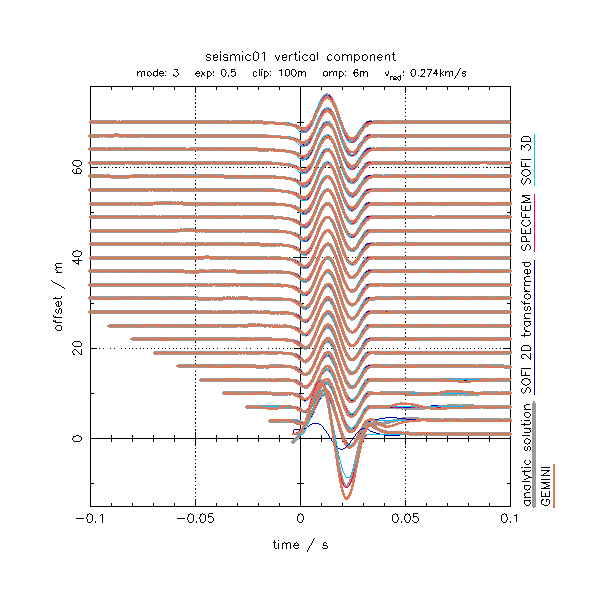-
Homogeneous halfspace
- Tested algorithms:
This benchmark case was applied to the following programs: SOFI2D (transformed), SOFI3D, SPECFEM, Gemini and an analytic solution
- Scale:
Shallow seismic data
Benchmark case: Homogeneous halfspace
Model description
The benchmark model for this case consists of a homogeneous halfspace (P-wave velocity 500 m/s, S-wave velocity 300 m/s and mass density 1800 kg/m³). An elastic wave propagation is assumed. A vertical force source is used as source. Download the model description for a detailed description of the benchmark test including the characteristics of the source and the acquisition geometry.
Compared algorithms
In this benchmark test five different forward solvers are compared: SPECFEM3D, Gemini II, SOFI3D, SOFI2D and an analytic solution. The results of SOFI2D are transformed to equivalent point-source seismograms. A description of the transformation is provided for download. Please note that proper physical amplitudes of the source are only implemented in SPECFEM3D, SOFI2D and the analytic solution.
The analytic solution basically is the solution to Lamb's (1904) problem. Seismograms are obtained from analytically derived Fourier-Bessel expansion coefficients through numerical wavenumber integration and Fourier expansion. A detailed description of the procedure is provided for download.
Time series for download
The calculated time series are provided for download.
The plots displayed on the left and additional zoomed views are provided for download (PDF file). The seismogram displays are produced with refractx. Plot parameters are given in the subtitle of each plot.
The parameter settings used for the plots are given in the label of each plot.
- mode: scaling mode
- 1: scale traces individually
- 2: scale all traces to first trace as reference
- 3: scale all traces to a common offset trace of each dataset as reference
- exp: traces are scaled by offset-dependent factor of (r/1m)exp where r is the offset
- clip: clipping level
- amp: amplitude level
- vred: timescale is reduced by tred=t-r/vred


